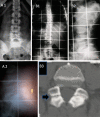AIS and spondylolisthesis
- PMID: 22569830
- PMCID: PMC3616469
- DOI: 10.1007/s00586-012-2326-8
AIS and spondylolisthesis
Abstract
Introduction: The association of scoliosis and spondylolisthesis is well documented in literature; the nature and modalities of the relationship of the two pathologies are variable and not always clear. Also, etiologic particulars of scoliosis associated with spondylolisthesis are not well defined, even in cases where scoliosis is called idiopathic. In this paper, we review previous literature and discuss the different aspects of the mutual relationship of scoliosis and spondylolisthesis in the adolescent age.
Materials and methods: It is a common notion that the highest occurrence of scoliosis associated with spondylolisthesis is at the lumbar level, both in adolescent and in adult patients. It is probable that the scoliosis that is more heavily determined by the presence of spondylolisthesis is at the lumbar level and presents curve angle lower than 15° Cobb and mild rotation. The scoliosis with curve value over 15° Cobb that is present at the lumbar level in association with spondylolisthesis probably is not prominently due to spondylolisthesis: in these cases, spondylolisthesis is probably only partially responsible for scoliosis progression with a spasm mechanism and/or due to rotation of slipping "olisthetic" vertebra.
Discussion: We think that the two pathologies should be treated separately, as stated by many other authors, but we would highlight the concept that, whatever be the scoliosis curve origin, spasm, olisthetic or mixed together, this origin has no influence on treatment. The curves should be considered, for all practical effects, as so-called idiopathic scoliosis. We think that generally patient care should be addressed to treat only spondylolisthesis or only scoliosis, if it is necessary on the basis of clinical findings and therapeutic indications of the isolated pathologies, completely separating the two diseases treatments.
Conclusions: Scoliosis should be considered as an independent disease; only in the case of scoliosis curve progression over time, associated scoliosis must be treated, according to therapeutic principles of the care of any so-called idiopathic scoliosis of similar magnitude, and a similar approach must be applied in the case of spondylolisthesis progression or painful spondylolisthesis.
Figures






References
-
- Arlet V, Rigault P, Padovani JP, Touzet P, Finidori G, Guyonvarch G. Scoliosis, spondylolysis and lumbosacral spondylolisthesis. A study of their association apropos of 82 cases in children and adolescents. Rev Chir Orthop Reparatrice Appar Mot. 1990;76(2):118–127. - PubMed
Publication types
MeSH terms
LinkOut - more resources
Full Text Sources
Medical

